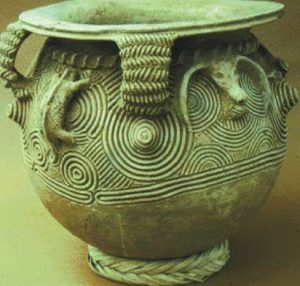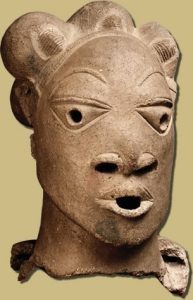Heritage
 Terracotta sculptures have also been recovered from Ile-Ife. They include the naturalistic sculpture in brass and pottery which were being produced sometime between AD 1110 and 1450. The subject matter of their work of arts included human and animal figures. Ife sculptures were made of copper alloyed with zinc and with relatively high quality of lead. Few of the objects were made of copper. The Ife sculptures have been placed around the 12th and 14th Century AD.
Terracotta sculptures have also been recovered from Ile-Ife. They include the naturalistic sculpture in brass and pottery which were being produced sometime between AD 1110 and 1450. The subject matter of their work of arts included human and animal figures. Ife sculptures were made of copper alloyed with zinc and with relatively high quality of lead. Few of the objects were made of copper. The Ife sculptures have been placed around the 12th and 14th Century AD.
Benin royal art consisted of bronze objects cast by the lost- wax process such as statuettes, stylized heads, some of which served as supports for carved elephant tusks and bas-reliefs representing historical events. Besides, the art of casting bronze, terracotta modeling also existed.
Ivory was also worked with outstanding virtuosity; among the varied objects produced were complete elephant tusks decorated either with basketry, weaving or matting. By and large, Benin had a large number of objects (over 2000) most of which, strictly speaking, should be referred to as brass objects. The few early Benin objects have been dated to about the 13th Century AD.
 Igbo-ukwu culture consisted of a large collection of objects and regalia of an important personality and objects from shrines. The manufacturing techniques fall into two categories: Perdue or lost wax technique and smiting/chasing method.
Igbo-ukwu culture consisted of a large collection of objects and regalia of an important personality and objects from shrines. The manufacturing techniques fall into two categories: Perdue or lost wax technique and smiting/chasing method.
The Igbo-Ukwuculture, which dated from 9th century AD, contained both chased copper objects and elaborate castings of lead bronze. The earliest artistic casting from black Africa, these pieces consist of ritual vessels and other ceremonial objects with intricate surface decoration.
 The history of Nigeria showcases a rich Cultural heritage. The earliest of this heritage is the Nok culture, which flourished extensively in the western part of Jos Plateau in Northern part of Nigeria between 900 BC and AD 200. Nok Culture also extended as far as KatsinaAla, Ankiring, Kagara, Taruga and Yelwa. It was characterized by distinctive ways of making terracotta figurines, mostly head of human beings.
The history of Nigeria showcases a rich Cultural heritage. The earliest of this heritage is the Nok culture, which flourished extensively in the western part of Jos Plateau in Northern part of Nigeria between 900 BC and AD 200. Nok Culture also extended as far as KatsinaAla, Ankiring, Kagara, Taruga and Yelwa. It was characterized by distinctive ways of making terracotta figurines, mostly head of human beings.
Other Nok artifacts included round stone axes, iron axe blades, small stone arrow points and barbs, quantities of pottery, among others. Not far from the Nok Culture area was the Daima culture with its simple clay animal bronze figures, which were by the 6th Century BC being made by a population of Neolithic herdsmen. At the settlement mound of Diama, in Northwestern Borno, south of Lake Chad, the people began to build circular huts of mud which had floors made of potsherd pavements. These fired clay figures included a humped cow, sheep or goats, wild animals and human beings.
NOTICE BOARD
Visa applications are being processed within stipulated time after submission to the Embassy. Applicants are requested to attach all relevant documents to avoid delay.
PASSPORT
The Mission does not have a passport issuing desk. However, passport intervention exercises are being conducted periodically in Ho Chi Min City and Hanoi by immigration officers from our Mission in Malaysia. Applicants will be notified accordingly of this exercises through our website.
Recent Posts
ADDRESS INFORMATION
Villa No. 44/1 phố Vạn Bảo,
Khu Ngoại Giao,
Đoàn Vạn Phúc, Quận Ba Đình,
Ha Noi 100000
Vietnam
Tel.: + 842437263610, + 842437263611
Fax: +84-24-37263615
E-mail: contact-us@nigeriaembassy.org.vn